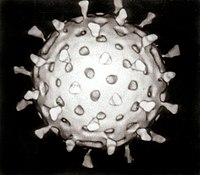
Photo from wikipedia
Background Human rotavirus A (RVA) infection is the primary cause of acute gastroenteritis (AGE) in infants and young children worldwide, especially in children under 5 years of age and is… Click to show full abstract
Background Human rotavirus A (RVA) infection is the primary cause of acute gastroenteritis (AGE) in infants and young children worldwide, especially in children under 5 years of age and is a major public health problem causing severe diarrhea in children in Thailand. This study aimed to investigate the prevalence, genotype diversity, and molecular characterization of rotavirus infection circulating in children under 15 years of age diagnosed with AGE in Thailand from January 2016 to December 2019. Methods A total of 2,001 stool samples were collected from children with gastroenteritis (neonates to children <15 years of age) and tested for RVA by real-time polymerase chain reaction (RT-PCR). Amplified products were sequenced and submitted to an online genotyping tool for analysis. Results Overall, 301 (15.0%) stool samples were positive for RVA. RVA occurred most frequently among children aged 0-24 months. The seasonal incidence of rotavirus infection occurred typically in Thailand during the winter months (December-March). The G3P[8] genotype was identified as the most prevalent genotype (33.2%, 100/301), followed by G8P[8] (10.6%, 32/301), G9P[8] (6.3%, 19/301), G2P[4] (6.0%, 18/301), and G1P[6] (5.3%, 16/301). Uncommon G and P combinations such as G9P[4], G2P[8], G3P[4] and G3P[9] were also detected at low frequencies. In terms of genetic backbone, the unusual DS-1-like G3P[8] was the most frequently detected (28.2%, 85/301), and the phylogenetic analysis demonstrated high nucleotide identity with unusual DS-1-like G3P[8] detected in Thailand and several countries. Conclusions A genetic association between RVA isolates from Thailand and other countries ought to be investigated given the local and global dissemination of rotavirus as it is crucial for controlling viral gastroenteritis, and implications for the national vaccination programs.
Journal Title: PeerJ
Year Published: 2021
Link to full text (if available)
Share on Social Media: Sign Up to like & get
recommendations!